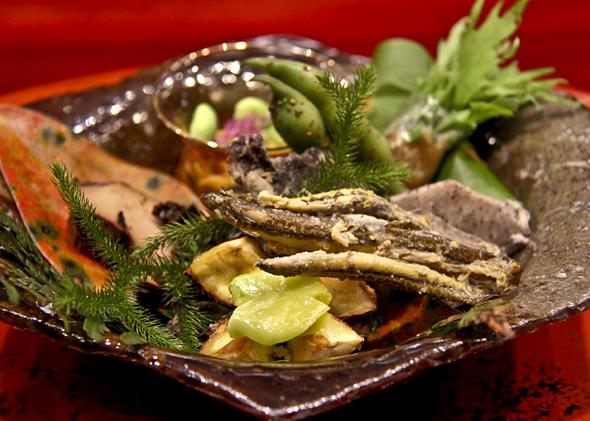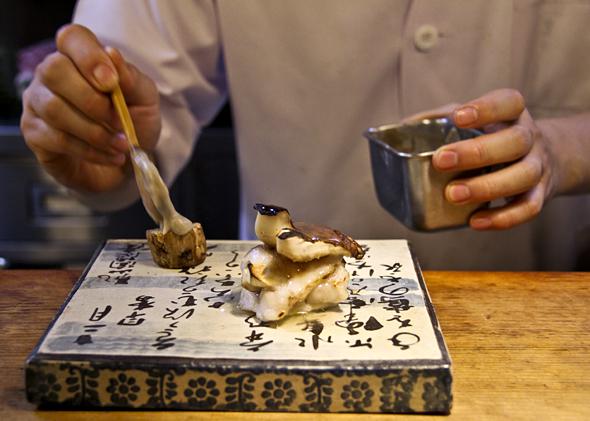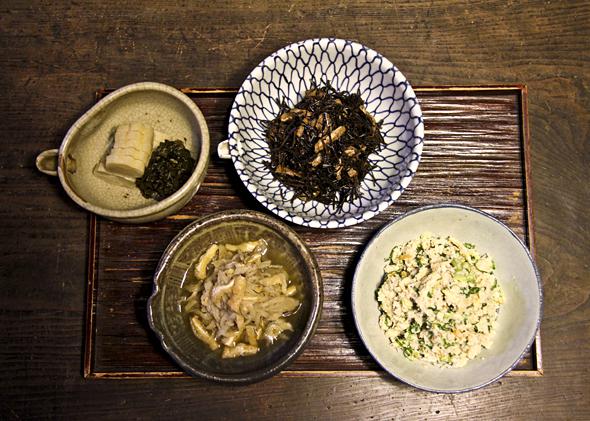Each Friday Roads & Kingdoms and Slate publish a new dispatch from around the globe. For more foreign correspondence mixed with food, war, travel, and photography, visit their online magazine or follow @roadskingdoms on Twitter.
KYOTO, Japan—The meal begins simply, almost religiously: a bowl of rice, a plate of pickles, a pot of green tea. Pour the tea over the rice and take a sip, then pinch a half moon of daikon between your chopsticks. Later comes a plate of tofu scraps dressed with green onions and dried fish, a seaweed salad, and a small bowl of miso soup.
This is obanzai, Japanese home-style cooking, but the cook is no ordinary homemaker: Setsuko Sugimoto is the matriarch of one of the oldest families in Kyoto, a city where everyone knows exactly how far your family goes back. Her home is older than the United States and protected by the Kyoto government. Tonight’s dinner stretches back to the Edo period, and to prove it she drops before me a telephone book–thick copy of the original recipes her family has preserved for 10 generations. “These are the traditions that we are starting to lose,” she tells me.
Not more than a few blocks from Sugimoto’s centuries-old home is a thicket of unwelcome invaders: Starbucks slinging monster soy lattes, a pizza delivery chain prepping seafood pies, a rainbow array of 24-hour convenience stores, portals of warmed-over carbohydrates and general gastronomic mischief. It’s a familiar tale: waves of brutish Western culture crashing on the shores of foreign countries and encroaching upon their long-held traditions. But the phenomenon is all the more striking here in Kyoto, in the heart of one of the world’s richest culinary cultures, with cooking traditions that stretch back millennia and more Michelin stars per capita than any other city in the world.
But Kyoto and the rest of Japan are not prepared to see their food yield to the mitigating forces of the modern world. Sugimoto is a part of a formidable coalition of government officials, nonprofit organizations, scholars, and food luminaries who have been working for two years on a proposal to include washoku—the traditional dining cultures of Japan—on the United Nations Educational, Scientific, and Cultural Organization’s list of “intangible world heritages.” On Thursday, they received word that their bid had advanced to the final stage, making Japanese cuisine all but certain to win this prized UNESCO designation in early December. It may seem a benign marker, but the UNESCO program is itself not without controversy. Moreover, it begs the question: Can a U.N. body’s imprimatur do anything to protect something as intangible as a style of cooking?

Photo courtesy of Matt Goulding
Most people know UNESCO as the cultural arm of the United Nations dedicated to protecting important landmarks and features in the physical world: Angkor Wat, the Grand Canyon, the Taj Mahal. But in 2008, they expanded their heritage protection program to include intangible cultural artifacts—as they describe them, “traditions or living expressions inherited from our ancestors and passed on to our descendants.” To date, they’ve added 257 items to their list of safeguarded customs, from well-known cultural staples like Brazilian Carnival to more obscure traditions like the gong culture of the Vietnamese highlands. Along with the petition to safeguard Japanese cuisine, there are 31 other proposals being examined this fall by the world body, including Korean kimchi-making, Turkish coffee culture, and the Belgian tradition of shrimp fishing on horseback.
UNESCO’s world heritage program has long been a magnet for controversy. Critics are quick to point out that the increased attention caused by a UNESCO distinction often threatens to undermine the very thing it seeks to protect. (A $1.6 million trip to all 962 sites offered by a luxury travel agent will do little to quell those concerns.) Others wonder if UNESCO has the funding and the organizational might to handle such a diverse and ambitious range of sites and traditions. The expansion into the intangible world can only make matters more complicated for an underfunded and overly bureaucratic organization.
To date, there are officially four UNESCO-designated cuisines: Mexican, Turkish, Mediterranean, and French. By any measure, if there is a distinction for the world’s most important, unique, or vital cuisines, Japan deserves to be at the top of the list. The depth and breadth of Japanese cuisine is stunning. In Hokkaido, you can feast on salty orbs of salmon roe and golden mountains of sea urchin for breakfast and plates of charcoal-grilled lamb for dinner. In the mountains along the Sea of Japan, you’ll find families that ferment their own soy sauce and miso and old men who have done nothing their entire lives but turn ground buckwheat into soba noodles. And in Tokyo, thousands of ramen bars and subterranean izakaya share cement with hushed temples of raw fish run by Jiro Ono, Japan’s most famous sushi master, and a crew of single-minded fish whisperers.

Photo courtesy of Matt Goulding
But no city is more important in representing and protecting the traditions of Japanese cuisine than Kyoto, capital of the ancient empire for more than 1,200 years and ground zero for Japan’s greatest culinary achievements.
Over the past week of eating here, I’ve talked to a lot of people about UNESCO: knife makers, sake brewers, line cooks. It’s a topic everyone in this food-obsessed town wants to discuss, and everyone I spoke with firmly believes that Japanese cuisine deserves the recognition, though the reasons why are as varied as the cooking itself.
“It’s the water,” says Setsuko Matsui, owner of the elegant Matsui Honkan inn who believes the mineral-rich water of places like Kyoto makes for better rice, better sake, better everything. “Japanese cuisine is dedicated to reflecting nature,” says Hisao Nakahigashi, one of Kyoto’s most respected chefs whose Michelin two-star kaiseki restaurant fills up six months in advance.
Yoshihiro Murata, president and chef of Kikunoi, one of the country’s most storied restaurants, says it all comes down to one word: umami, the deeply savory taste that forms the basis of Japanese cuisine. “Western cuisines are based on fat,” he says, “but Japanese gets its flavor from umami, which has zero calories. That’s why we live longer than everyone else.”
If anyone understands why Japanese cuisine is deserving of distinction, it’s Murata. Not only does he captain a famed restaurant and kaiseki juggernaut, but as chairman of the Japanese Culinary Academy, he is the one who approached the government about seeking out UNESCO heritage status. “These are ancient traditions, and they need to be maintained,” Murata says.
But therein lies the challenge for UNESCO. Whereas preserving a building or a monument is relatively straightforward, the objective of the intangible heritage program is considerably more opaque. UNESCO officials are careful not to use the words protect or preserve, as it implies freezing or impeding growth. What’s at hand is even more delicate: educating communities on the importance of their greatest cultural traditions, without stunting their development or dictating their future.

Photo courtesy of Matt Goulding
“We’re not talking about locked practices,” says Edmond Moukala, a program specialist for UNESCO’s Division of Cultural Policies and Intercultural Dialogue. “Some of these traditions have existed for centuries, and they have been transmitted through their own internal mechanics. We just try to check that these transmission mechanics are sustainable. If they’re not, then we step in to help.”
Moukala points out that some countries’ traditions are in immediate danger, whether from war or crippling economic conditions, in which case UNESCO takes a more active role in helping to safeguard them. But the vast majority of intangible heritage designees are more susceptible to the entropy of globalization than the immediate threat of a calamitous event. So in most cases, the UNESCO distinction is little more than a public recognition of a unique cultural practice. Then, says Moukala, it’s up to the government and the local communities to honor the designation properly.
But that hasn’t always proved successful.
In 2010, French cuisine was recognized specifically for the “French gastronomic meal,” a nod to the tradition of gathering with family and friends over long, drawn-out homemade feasts. To celebrate, a brigade of the country’s Michelin-starred chefs threw themselves a lavish party at Versailles, essentially co-opting a distinction reserved for a humbler style of cooking.
Japan is already showing a wide-spanning view on what a UNESCO intangible heritage listing could mean. Prime Minister Shinzo Abe has pledged to double Japanese exports by 2020, and many think the UNESCO brand may help him reach his goal. Chef Murata talks about food security and the need for Japan to produce more of its own calories. “This isn’t about now, it’s about 50 years from now. Who would help us if we ran out of food? Not the Western world,” he says. He believes the UNESCO distinction may help boost domestic agriculture.
Most likely the distinction will be shaped by the beholder. Citizens will embrace it as a source of national pride in a country weakened by a tough economy and the residue of the Fukushima disaster. The Abe government and savvy entrepreneurs may try to use the newfound status to export Japanese luxury items. Chefs and culinary practitioners will hopefully do exactly what they’re supposed to do: pass traditions on to the next generation.
The only sentiment that everyone seems to share is the overwhelming desire to achieve the UNESCO milestone. A recent poll asked citizens about their opinion of Japan’s bid to have its cuisine safeguarded. Ninety-two percent of respondents said they fully support the bid. The other 8 percent, presumably, still had their mouths full.
